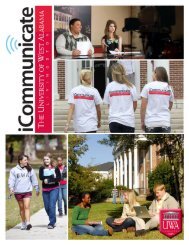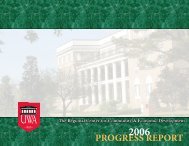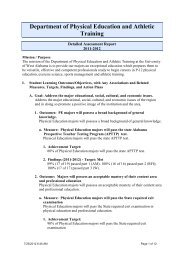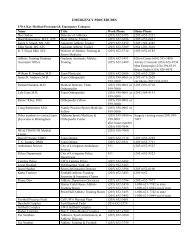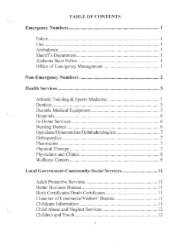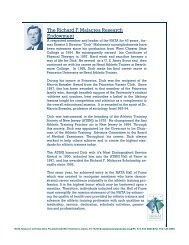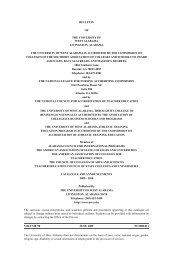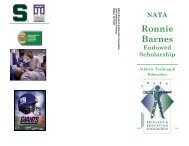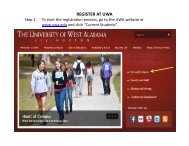table of contents - UWA Athletic Training & Sports Medicine Center
table of contents - UWA Athletic Training & Sports Medicine Center
table of contents - UWA Athletic Training & Sports Medicine Center
You also want an ePaper? Increase the reach of your titles
YUMPU automatically turns print PDFs into web optimized ePapers that Google loves.
OTHER LIGHTNING SAFETY TIPS: (2011-2012) NCAA <strong>Sports</strong> <strong>Medicine</strong> Handbook)1. There should be no contact with metal objects (bleachers, fences, golf clubs, bats)2. Avoid single or tall trees, tall objects and standing in a group.3. If there is no other shelter you may seek refuge in a hardtop vehicle. It is not the rubber tires that protect fromlightning; it is the hard top metal ro<strong>of</strong> that dissipates the lightning around the vehicle. Roll up the windows. Donot touch the sides <strong>of</strong> the vehicle4. The existence <strong>of</strong> blue skies and/or absence <strong>of</strong> rain are not protection from lightning. Lightning can strike 10miles from the rain shaft.5. DO NOT LIE FLAT ON THE GROUND6. Avoid using a land line telephone. Cell phones are a safe alternative if in a safe structure.7. Avoid standing water and open fields8. If in a forest, seek shelter in a low area under a thick grove <strong>of</strong> small trees.9. If you feel your skin tingling immediately crouch and grab your legs and tuck your head as describedabove to minimize your body’s surface area.10. Persons who have been struck by lightning do not carry an electrical charge. Therefore, enact the EMS systemand provide emergency care. CPR with an AED is what is most <strong>of</strong>ten required. If possible, move the victim toa safe location.11. For additional information refer to the National Lightning Safety Institute at www.lightningsafety.comDIRECTIONS FOR USING THE Telvent (DTN) RADAR & LIGHTNING DETECTOR.1. Prior to practice or competition, monitor weather forecast via the Internet or by calling local agencies for up todate information.2. Check for any National Weather Service-issued thunderstorm “watches” and “warnings”.3. Monitor the weather for the following: sudden decrease in temperature, increase in air movement, suddenincrease in humidity, visible dark clouds (though these do not have to be present for a lightning strike to occur)4. Communicate with <strong>of</strong>ficials and/or head coach prior to activity about potential for bad weather and ourmonitoring system.5. Locate the Telvent (DTN) Lightning/Storm Detector in an area removed from other electronic devices ormachinery, which could cause a false triggering.6. Telvent (DTN) works via the internet accessed via cell phone.7. Telvent (DTN) will also notify <strong>Athletic</strong> Trainers via text messaging.8. Telvent (DTN) will also be accessible on the Head <strong>Athletic</strong> Trainers’ Desk Top Computer9. Upon lighting strike the Head <strong>Athletic</strong> Trainer or his/her designee will contact all <strong>Athletic</strong> <strong>Training</strong> Staff <strong>of</strong> alighting threat in the area.10. When lightning is within 20 miles, the game <strong>of</strong>ficials should be notified, if it is a game the tarp should be placedat that time.11. Activity will be suspended when:A. Telvent (DTN) registers 2 consecutive lightning strokes within the 8-20 mile rangeB. The Flash/Bang Method reveals lightning within a 6 mile range (30 second or less count between the flash<strong>of</strong> lightning and the bang <strong>of</strong> thunder)12. Once you have determined that there is imminent danger <strong>of</strong> a lightning strike, communicate to the head coachand/or head <strong>of</strong>ficial.13. Evacuate the field and stands to an enclosed-grounded building. REMEMBER, a golf cart, automobile, or openshelter does not provide protection from a lightning strike. If there is no available shelter IE, cross-country,each individual should seek an area that is flat and in the open. Crouch down wrapping your arms around yourknees and remain in that position until the danger <strong>of</strong> lightning has passed.14. Activity may be resumed only IF the danger <strong>of</strong> a lightning strike is no longer present and no lightning strikeshave occurred within the 20 mile range in 30 minutes. This decision to resume activity is to be made by amember <strong>of</strong> the <strong>Athletic</strong> <strong>Training</strong> Staff, <strong>Athletic</strong> Director, or Head Official.FLASH-to-BANG Lightning Detection MethodThis method <strong>of</strong> lightning detection should be used in conjunction with the Telvent (DTN) radar system.1. Prior to practice or competition, monitor weather forecast to include calling local agencies for up to dateinformation.2. Watch for the flash <strong>of</strong> lightning.3. Begin to count (one one thousand, two one thousand . . . . )59




